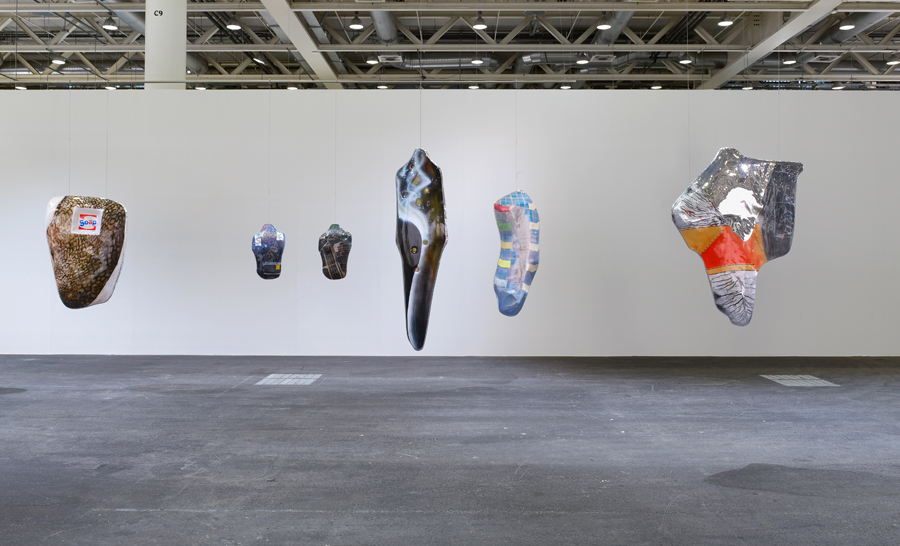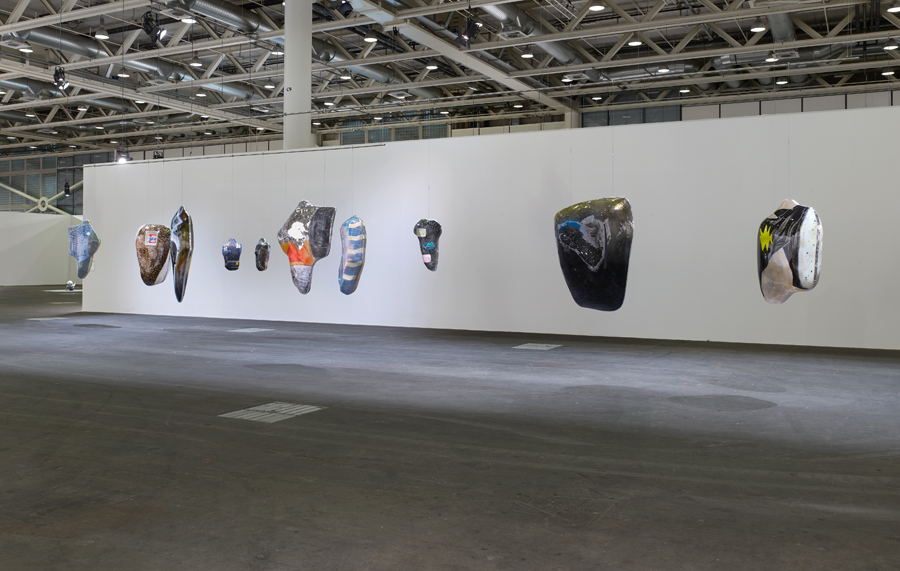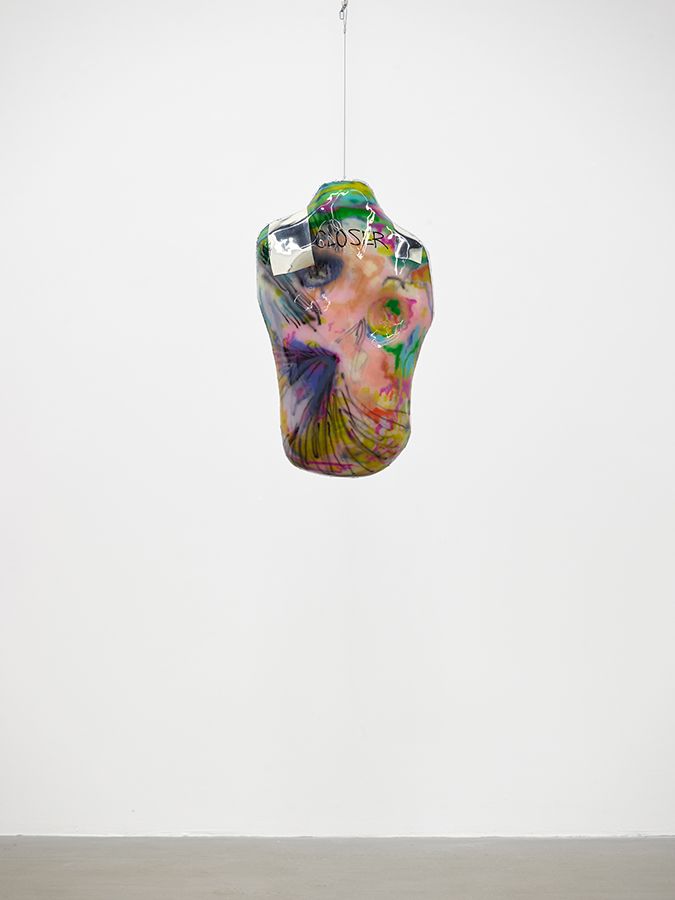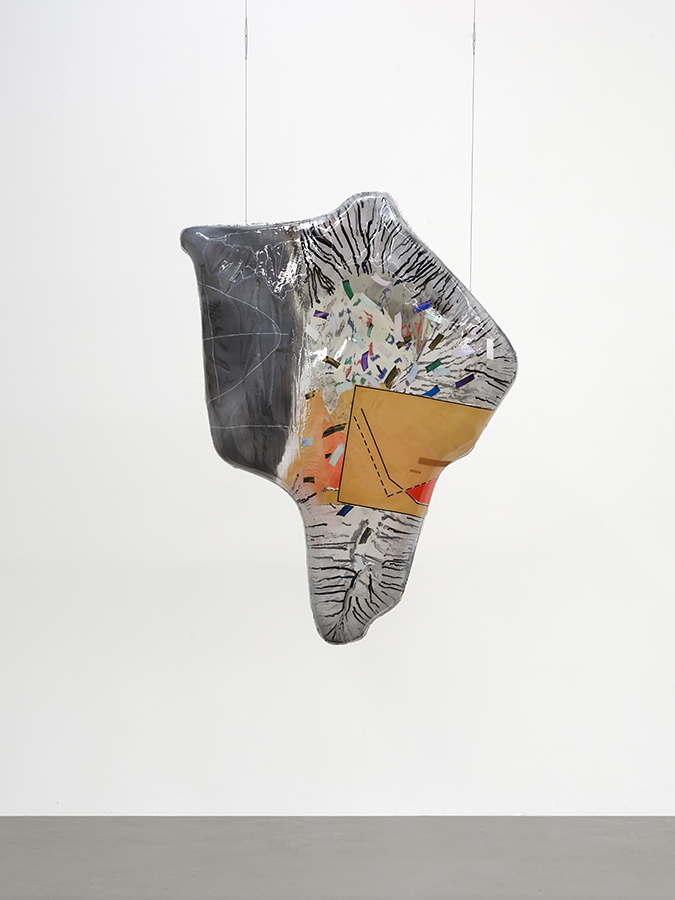
Moss’s sculptures are not passive, but active; not static, but in motion; not fractional, but whole. They do not hang heavily, but seem to float up, buoyed with light and air. They are responsive: they turn, gently, in the currents generated by the movement of the viewer. They are not dead, but very much alive.
They are best described not as bodies, but – as the artist has often insisted – as figures. She explains that the terms “figure,” or “figuring,” have more assertive, relational and subjective associations than the passive or corporeal “body.” Moss’s sculptures, each one autonomous and independent from the other, are more concerned with particular outlooks or sensibilities than with surface appearance. They are existential expressions of what it is to be in the world, rather than what it is to be seen – or, perhaps more accurately, what it is to be in the world when one is conscious of being seen….
Often, Moss’s sculptures take overt anthropomorphic form – as with the earlier work Mocker (with Brassiere) (2017), or the recent pieces Constellator Cancer, Constellator Scorpio and Constellator Sculptor (all 2021), all of which share a mould for a shape resembling a limbless torso. In earlier pieces that contained smaller forms nested within them, it is easy to read the shapes inside – an apple, a pear, a bottle, hearts – as things consumed, or as organs. In other works, Moss sets up relations between pairs of sculptures (“couples,” as she calls them), a formal sculptural device which unavoidably leads to our projection of human – or, at the very least, animate – relations between them.

But in many instances, her sculptures seem humanoid only in spirit; “humane,” as the artist puts it. The elongated Launcher (2021), for example, evokes a punching bag or a weather balloon. Shuttler (2021) is triangular like a bike saddle or – as its title alludes – a space shuttle. These pieces draw inspiration from the extraordinary vehicles in which we propel bodies through space (both terrestrial and outer), and also from another vertically-oriented expression of human ambition: the astonishing structure of Cologne Cathedral. In these instances, her sculptures approach a subjectivity all their own: they want to go places; they aspire to transcend.
While Moss admits to thinking of her sculptures often as characters or individuals, it is reductive to think them only as figures. Moss is concerned not only with (or scarcely with) corporeal skins but rather with all the other kinds of skin that might carry or contain us: clothing, especially sportswear, but also vehicles, spacecraft, buildings, territories and terrains. In ‘Horizon Figures,’ works posit relations to places both micro and macro, architectural and cosmic, from a stone found in her backyard to maps of the night sky. The sculpture Mariner, for example, combines a map of all the rivers in Cologne with a diagram of glacial melt. Relations are established both between the distinct elements within a sculpture and between those elements and the viewer….

Not quite a skin but definitely a container, language frequently appears in Moss’s sculptures. In Orator (2021), a passage from tort law is inscribed on one side; Moss has confessed she enjoys the conceit of one sculpture lodging a complaint against its neighbour. As subjects, we are contained by the language of law just as we are by economic, social and political structures.
Elsewhere, language features not as an appropriated quotation or logo but applied with specific intent by the artist. The words “close” and “closer” appear on either side of the torso-shaped sculptures Stargazer 1 and 2 (2021), which Moss has also painted with maps of the night sky as seen from Mars (with Earth in it), and of the night sky as seen from Earth (with Mars in it). Distance – a word and an abstraction we have all been forced to reckon with during the pandemic – is shown to be highly relative, an unfathomably elastic notion that can comprise both the intimacy of human closeness and the remoteness of deep space. As with all of Moss’s work, Stargazer 1 and 2 ask us to hold divergent ideas in our minds at once, ideas that flex and threaten to peel apart but which are bound together in the sealed systems of her sculptures.
All of these observations contribute to an understanding of Moss’s work as being time-based, in one way or another. Frequently drawing from images and objects that are designed for movement, her sculptures feel ready to go, built for speed. (Slowness features too, often as a flipside: recall the glacial melt, the star charts, or the speckled granite from her yard.) Speed, like distance, is entirely relative. The sculptures themselves move in space, twisting on their hanging cables, even if imperceptibly slowly.
Moss plays with notions of time in other, more expansive ways too. In two torso-shaped sculptures from 2018, Romanettes (with double Hearts), she constructed a temporal relation between the front and the back of each form. On one side, she wrote “TONIGHT…”, and on the other, “TOMORROW…”. The works rotate endlessly, formally and conceptually, oriented towards the future and the sense of potential – indeed, multiple potentials – offered by the unspooling of time. If Romanettes (with double Hearts) implies the possibility of future actualization or redemption, other works allude to a less optimistic relation to the future. Driver (With Passenger (With Heart)) included a prognosis of a “market crash, Summer 2019” – several months after the work was made and first shown. (It did not arrive, of course, but it could have.) In Speculator and Predictor (both 2021), torso shapes bear the words “SUDDENLY” on one side, above a photographic view of the cosmos, and “NOW” on the other, above a gridded star map overlaid with zodiacal signs.
The extremes of scale – of space, of distance, of time, of profundity and mundanity – that are compacted into Moss’s sculptures are sometimes challenging to keep a grasp of. It is as if the forms are containers into which the artist tries to pour more than they can physically hold. The metallic strip, with which Moss binds the work together, sometimes feels fit to burst. Which, indeed, is often how it feels to be alive.
Text by Jonathan Griffin






